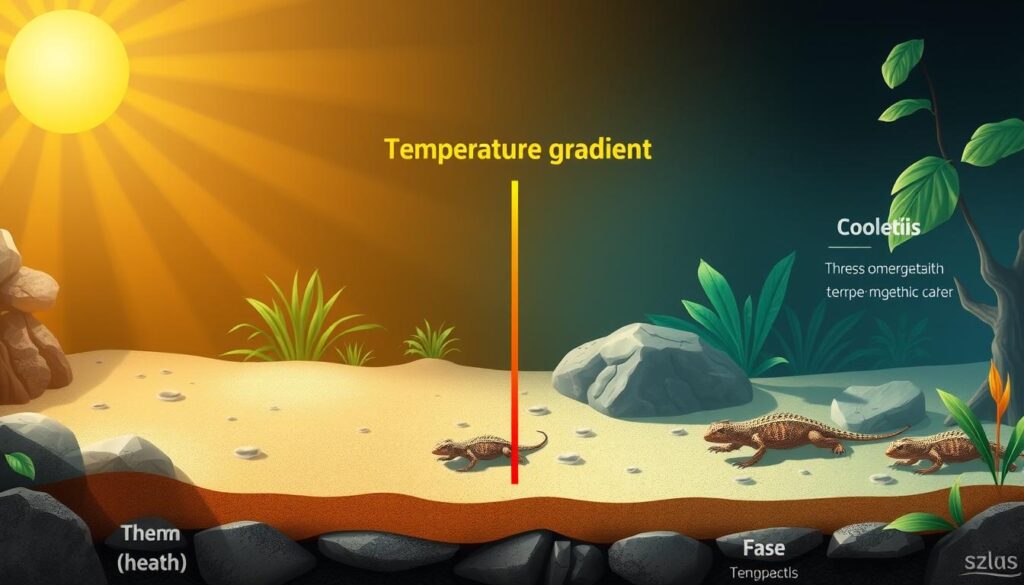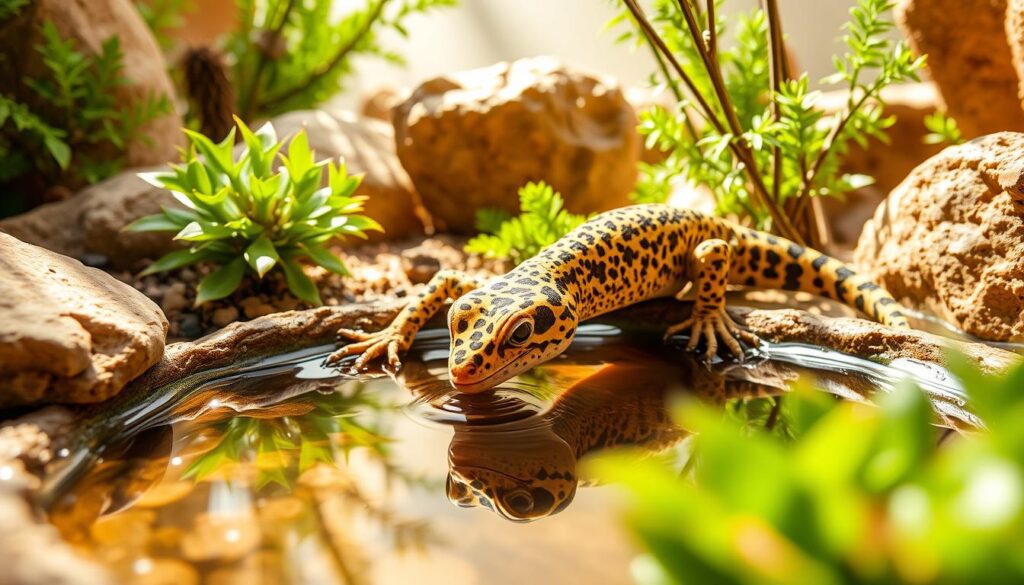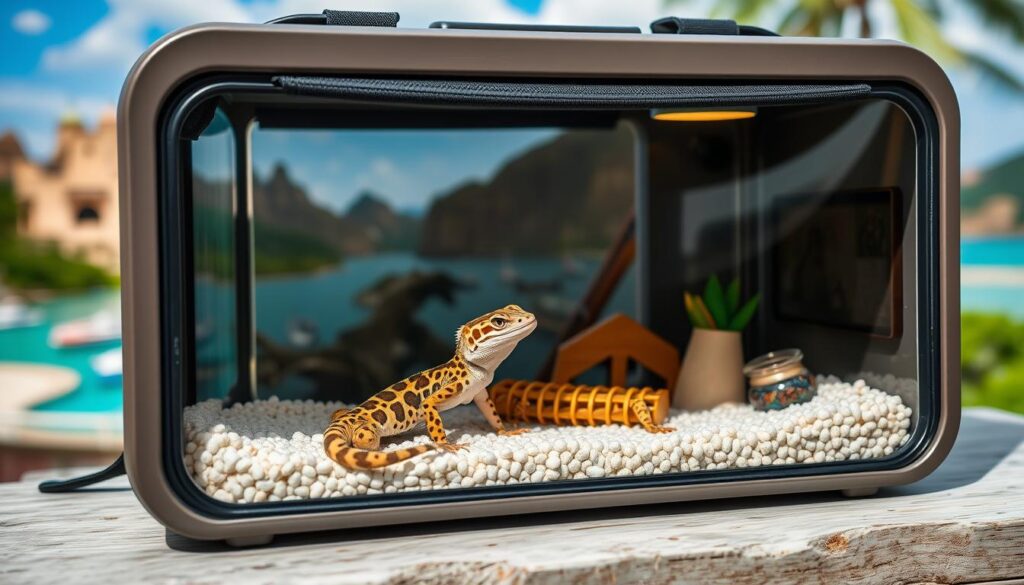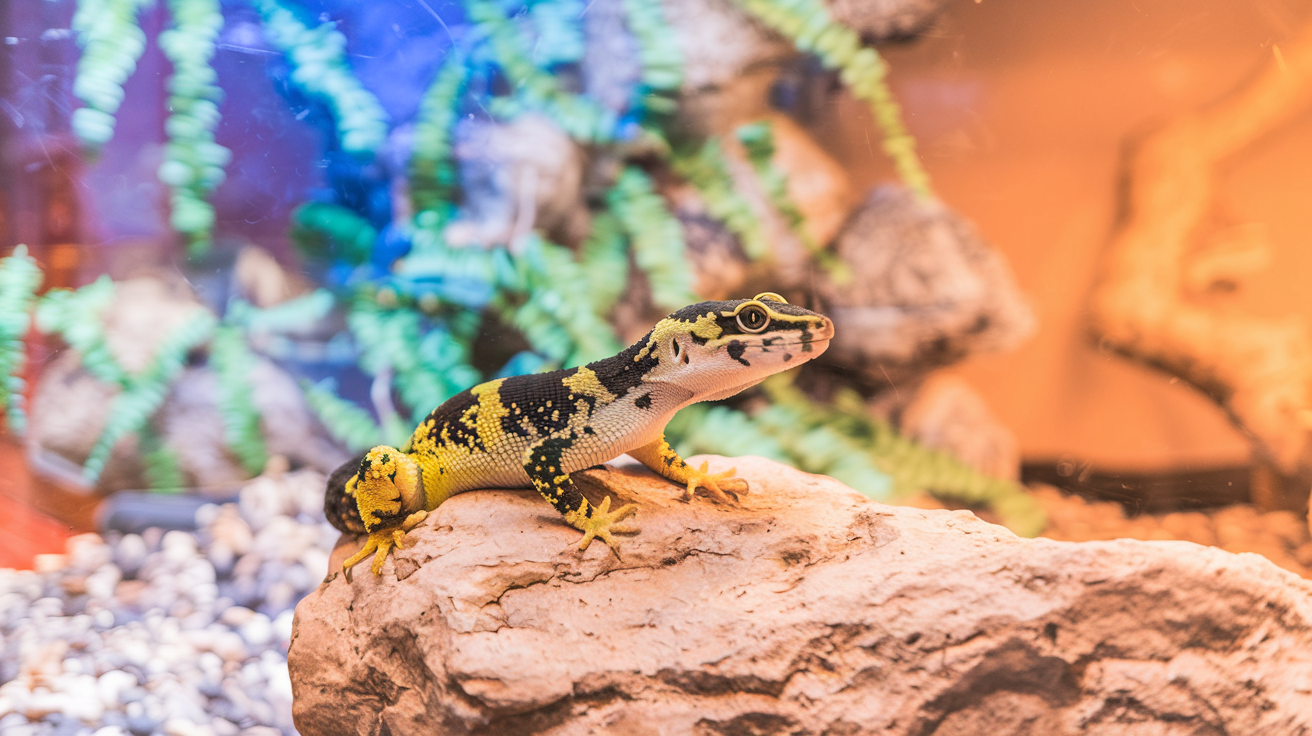Leopard geckos are great for beginners because they are gentle and easy to care for. They are perfect for those new to owning reptiles. This guide will cover everything you need to know about caring for them, from setting up their habitat to feeding and health checks.
Whether you’re new to reptiles or have experience, this guide will help you care for your leopard gecko. They are low maintenance and can live a long time, making them a favorite among reptile lovers.
Key Takeaways
- Leopard geckos are a popular choice for beginner-friendly reptiles
- They have a gentle temperament and are easy to handle
- Proper care includes a well-designed habitat and a balanced diet
- Regular health monitoring is crucial for preventing common health issues
- With proper care, leopard geckos can live a long and healthy life
Why Leopard Geckos Stand Out Among Best Reptiles for Beginners
Leopard geckos are easy for beginners because they are gentle and don’t need much care. They are perfect for those new to reptile care. They offer a chance to enjoy reptile ownership without the stress of caring for a difficult pet.
Some key reasons leopard geckos are great include:
- They are gentle, making them easy to handle and less likely to bite.
- They need simple care, like easy habitats and not much food.
- They can live up to 20 years, making them a long-term friend.
- They are healthy, which means they can be your pet for a long time.
These traits make leopard geckos a great choice for anyone wanting a reptile. With the right care, they can live happily and entertain you for years. That’s why they are often suggested for beginners and are a favorite among novice keepers.
Leopard geckos are a wonderful choice for anyone wanting to own a reptile. Their calm nature, simple care, and long life make them perfect for both new and experienced owners.
| Characteristics | Description |
|---|---|
| Gentle Temperament | Leopard geckos are known for their calm and gentle nature, making them easy to handle and less likely to stress or bite. |
| Low Maintenance Requirements | Leopard geckos have simple habitat needs and infrequent feeding requirements, making them a low-maintenance pet. |
| Long Lifespan | Leopard geckos can live up to 20 years in captivity, making them a long-term companion for dedicated owners. |
Essential Habitat Setup Requirements
Creating a habitat for reptiles like leopard geckos is key. It should mimic their natural home. You’ll need a well-structured space with heat lamps and thermometers. A tank size of 10-20 gallons is best for one gecko.
Adding décor like hides and climbing structures is a good idea. It makes your gecko feel at home and keeps them entertained. For beginners, a simple setup is best. Important items include:
- A heat source, such as a heat lamp or ceramic heat emitter
- A thermometer to monitor temperature
- A hygrometer to monitor humidity
- A substrate, such as sand or reptile carpet
- Hides and climbing structures
By setting up a good habitat, you’ll make your leopard gecko happy and healthy. Leopard geckos are great pets for beginners. They are easy to care for and can bring lots of joy.
Creating the Perfect Temperature Gradient
For suitable reptiles for newcomers, like leopard geckos, a temperature gradient is key. It means having a warm and cool side in their habitat. This lets them control their body temperature naturally. It’s vital for recommended beginner reptiles like leopard geckos, as they can’t handle big temperature changes.
Experts say you can make a temperature gradient with heat lamps, ceramic heat emitters, or heating pads. Using thermostats and thermometers is also crucial for keeping the temperature right. For more details, check out this website for a full guide.
Here are some important things to remember when setting up a temperature gradient:
- Warm basking area: 88-92°F
- Cooler side: 75-80°F
- Nighttime temperature: 65-75°F

By following these tips and using the right tools, you can make a great temperature gradient for your leopard gecko. This will help them stay healthy and happy. Always do your research to know the exact temperature needs of your recommended beginner reptiles for the best care.
Humidity and Substrate Choices
Creating a good home for leopard geckos is key. They need the right humidity levels, between 30-40%. Use a hygrometer to check the humidity in their enclosure.
A humid hide helps with shedding and health. You can use a plastic container with moist paper towels or a commercial humid hide. This provides a humid spot for your gecko to hide when needed. Some people use misting systems, but be careful not to make it too humid.
Choosing the right substrate is also important. You can pick reptile carpet, paper towels, or bioactive substrates. Some, like sand, are not good because they can cause impaction. Here are some good options:
- Reptile carpet: easy to clean, but may not be suitable for bioactive setups
- Paper towels: inexpensive, easy to replace, but may not be the most aesthetically pleasing option
- Bioactive substrates: can help maintain a healthy environment, but may require more maintenance
Understanding humidity and substrate choices helps create a great home for your leopard gecko. They are perfect for beginners because they are easy to care for.
| Substrate Option | Pros | Cons |
|---|---|---|
| Reptile Carpet | Easy to clean, durable | May not be suitable for bioactive setups |
| Paper Towels | Inexpensive, easy to replace | May not be aesthetically pleasing |
| Bioactive Substrates | Helps maintain a healthy environment | May require more maintenance |
Feeding Your Leopard Gecko
Leopard geckos are great for beginners because they’re easy to feed. They need a balanced diet to stay healthy. Their diet should include insects like crickets, mealworms, and dubia roaches.
It’s important to feed your leopard gecko a variety of insects. This ensures they get all the nutrients they need. Some good insects for them are:
- Crickets: rich in protein and calcium
- Mealworms: high in protein and fiber
- Dubia roaches: rich in protein and low in fat
Also, make sure to gut-load the insects before feeding them to your gecko. This means feeding the insects a nutrient-rich diet first.
Insect Diet Variety
Leopard geckos need a diet full of calcium and vitamins, especially when they’re growing. As a beginner-friendly reptile, it’s key to give them a balanced diet. Use a good quality insect food to gut-load the insects, and add calcium and vitamin D3 supplements as needed.
Feeding Schedule by Age
The feeding schedule for leopard geckos changes with age. Young geckos need to eat every day, while adults can eat 2-3 times a week. Knowing the right feeding schedule for your gecko’s age is important for their health.
Supplements and Vitamins
Supplements and vitamins are vital for the health of reptiles like leopard geckos. Adding calcium and vitamin D3 supplements to their diet is important. But, use these supplements carefully to avoid giving too much.
| Insect | Calcium Content | Vitamin D3 Content |
|---|---|---|
| Crickets | High | Low |
| Mealworms | Medium | Medium |
| Dubia Roaches | High | High |
Water and Hydration Needs
Keeping the water fresh and clean is key for leopard geckos’ health. They are ideal reptiles for newbies. A shallow dish of water that’s easy to reach is needed. This water is important for shedding, digestion, and staying healthy.
Leopard geckos also need a humid environment to do well. Mist their enclosure to keep the humidity right. This helps with hydration, especially when they shed. Knowing how much water your pet needs is crucial for their care.

Here are some important points about water and hydration for leopard geckos:
- Provide a shallow water dish that’s easy to get to.
- Keep the humidity right with misting.
- Make sure fresh, clean water is always available.
Following these steps can keep your leopard gecko happy and healthy. As ideal reptiles for newbies, they’re perfect for beginners. With the right care, including water and hydration, you can give your pet the best life.
Health Monitoring and Common Issues
Leopard geckos are great pets for beginners. They are easy to care for. But, it’s important to watch their health to avoid problems. They need the right environment and food to stay healthy.
Healthy leopard geckos have clear eyes, smooth skin, and are active. But, they can get sick with diseases like metabolic bone disease, impaction, and respiratory infections. These can be stopped with good care and attention.
It’s key to find a vet who knows about reptiles for regular check-ups and emergencies. Watch out for health issues like:
- Metabolic bone disease, caused by not enough calcium and vitamin D3
- Impaction, from eating substrate or other things they shouldn’t
- Respiratory infections, from bad air or wrong temperatures
Knowing about these health problems and how to stop them can help your gecko live a long, healthy life. Always do your research and talk to a vet if you’re worried about your pet’s health.
| Health Issue | Symptoms | Prevention |
|---|---|---|
| Metabolic bone disease | Weakened bones, lethargy | Provide a balanced diet with calcium and vitamin D3 supplements |
| Impaction | Loss of appetite, lethargy | Avoid using loose substrates, provide a varied diet |
| Respiratory infections | Wheezing, lethargy | Ensure proper ventilation, maintain a clean environment |
Handling and Socialization Techniques
For beginner pet reptiles, like leopard geckos, handling and socialization are key. They help build trust and reduce stress. Leopard geckos are calm and easy to handle, making them perfect for beginners.
When you handle your leopard gecko, make sure to support its body and limbs. Avoid grabbing the tail, as it can hurt your pet.
Start with short handling sessions, like 5-10 minutes. As your pet gets more comfortable, you can handle it for longer. Watch for signs of stress, like rapid breathing or hiding. This way, you can make handling more enjoyable for your pet.
Here are some tips for handling and socializing your leopard gecko:
- Move slowly and gently to avoid startling your pet
- Support your leopard gecko’s body and limbs at all times
- Avoid handling your pet during shedding or molting, as this can be stressful
- Provide a variety of environmental enrichments, such as hiding places and climbing structures, to stimulate your pet’s natural behavior
By following these tips, you can build a strong bond with your pet. Remember, handling and socialization are crucial for beginner pet reptiles. With patience and practice, you’ll become an expert in caring for your leopard gecko.
| Handling Tips | Benefits |
|---|---|
| Support body and limbs | Reduces stress and prevents injury |
| Move slowly and gently | Helps your pet feel more secure and relaxed |
| Provide environmental enrichments | Stimulates natural behavior and reduces boredom |
Breeding and Gender Differences
For novice keepers, breeding top reptiles like leopard geckos can be exciting. Leopard geckos are great for beginners because they are easy to care for. Knowing your geckos’ gender is key for breeding. You can tell by looking at their tails and how they act.
Male leopard geckos have bigger tails and more visible pre-anal pores. Knowing these differences helps with successful breeding.
Determining Gender
- Observe the tail size and shape: Males have larger, more muscular tails.
- Check for pre-anal pores: Males have more pronounced pre-anal pores.
- Look for hemipenal bulges: Males have bulges on either side of the vent.
Breeding Season Care
During breeding season, feed your female leopard geckos more and give them extra calcium. This helps them lay eggs. A good diet and care are key for a successful season.
Egg Incubation
Incubating eggs needs careful attention to temperature and humidity. Keep the temperature between 85-90°F and humidity at 50-60%. Incubation lasts about 60-70 days.
| Incubation Stage | Temperature | Humidity |
|---|---|---|
| Egg laying | 85-90°F | 50-60% |
| Incubation | 85-90°F | 50-60% |
| Hatching | 85-90°F | 50-60% |
Common Behavioral Patterns
Leopard geckos are great pets for beginners. They have interesting behaviors that are fun to watch. Knowing these patterns helps you care for them better and keep their environment stress-free. They are mostly active at night and like to burrow and hide.
They might wag their tails when excited or upset. Shedding is also common as they grow. It’s essential to recognize these behaviors to keep your pet happy and healthy. Leopard geckos are easy to care for, but knowing their needs is key.
Here are some key behaviors to look out for:
- Nocturnal habits: leopard geckos are most active at night
- Burrowing: they have a natural instinct to dig and hide
- Shedding: a natural process as they grow and develop
- Vocalizations: leopard geckos can make various sounds to communicate
Understanding these behaviors helps you care for your leopard gecko better. This way, you can create a happy and healthy home for them. Remember, leopard geckos are perfect for new pet owners. With the right care, they can become wonderful pets.
| Behavior | Description |
|---|---|
| Tail wagging | Can indicate excitement or aggression |
| Shedding | A natural process as they grow and develop |
| Nocturnal habits | Most active at night |
Tank Maintenance and Cleaning Schedule
Leopard geckos, being beginner-friendly reptiles, need a clean tank to stay healthy. Their habitat should be easy to keep clean. A regular cleaning schedule is key to keeping their environment clean and healthy.
Visit petsrelax.com to learn about the importance of a clean habitat. Daily care includes spot cleaning, refreshing water, and removing uneaten food. This prevents bacteria buildup and keeps the environment clean.
Daily Care Routine
- Spot clean the tank to remove any feces or uneaten food
- Refresh the water to ensure it’s clean and fresh
- Remove any uneaten food to prevent spoilage
Weekly cleaning tasks include changing substrates and disinfecting dishes. This keeps the environment clean and healthy for your pet.
Weekly Cleaning Tasks
A monthly deep clean is also needed. This includes replacing the substrate, disinfecting the enclosure, and checking equipment. It ensures the tank stays clean and healthy.
Traveling with Your Leopard Gecko
Traveling with easy reptiles for beginners can be tough. But with the right planning and gear, your leopard gecko’s trip can be safe and comfy. It’s key to think about what your beginner pet reptiles need.
First, check the laws about taking reptiles on trips in your area. This can prevent fines or trouble. Also, get a good travel box that keeps your gecko cool, safe, and comfy.
Here are some important things to remember for your gecko’s trip:
- Keep the temperature between 75-85°F (24-29°C)
- Make sure your gecko has water to drink
- Try to keep your gecko calm and handle them less
- Use heat packs or insulated boxes to keep the right temperature
Don’t forget to plan for your gecko’s food and water needs. Bring enough food and water, and stick to their usual eating times.

With careful planning, you can make your trip with your leopard gecko fun and safe. Always check local laws and do your best to keep your gecko happy and healthy.
| Travel Container Requirements | Description |
|---|---|
| Ventilation | Adequate airflow to prevent overheating and stress |
| Security | A secure and escape-proof container to prevent injury or loss |
| Temperature Control | A stable temperature range between 75-85°F (24-29°C) to maintain the gecko’s health |
Conclusion
Leopard geckos are truly the best reptiles for beginners and top reptiles for novice keepers. They are gentle, easy to care for, and live a long time. With the right habitat, food, and care, your leopard gecko will be happy and a great friend.
To be a great leopard gecko owner, keep learning and stay updated on care tips. Join online reptile groups, talk to experienced breeders, and check out trusted websites. This way, you’ll make sure your gecko is happy and healthy for years.
Keeping a leopard gecko is a rewarding experience. You’ll get to see their amazing adaptations and behaviors. By following this guide, you’ll create a wonderful home for your new pet. Start this journey and enjoy the many benefits of being a responsible leopard gecko owner.

